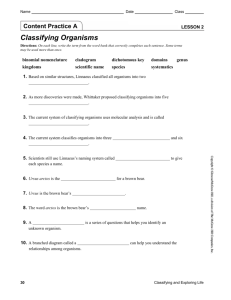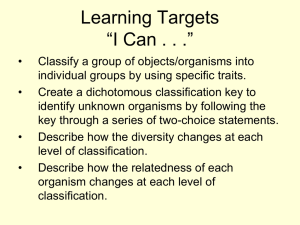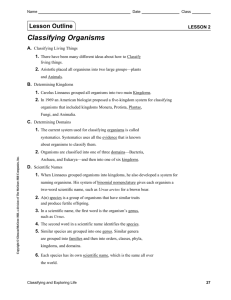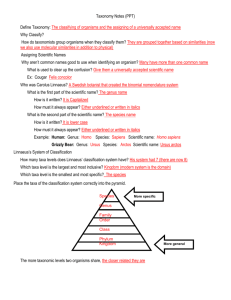Ch.1 Lesson 2 Key Concept Builder WITH
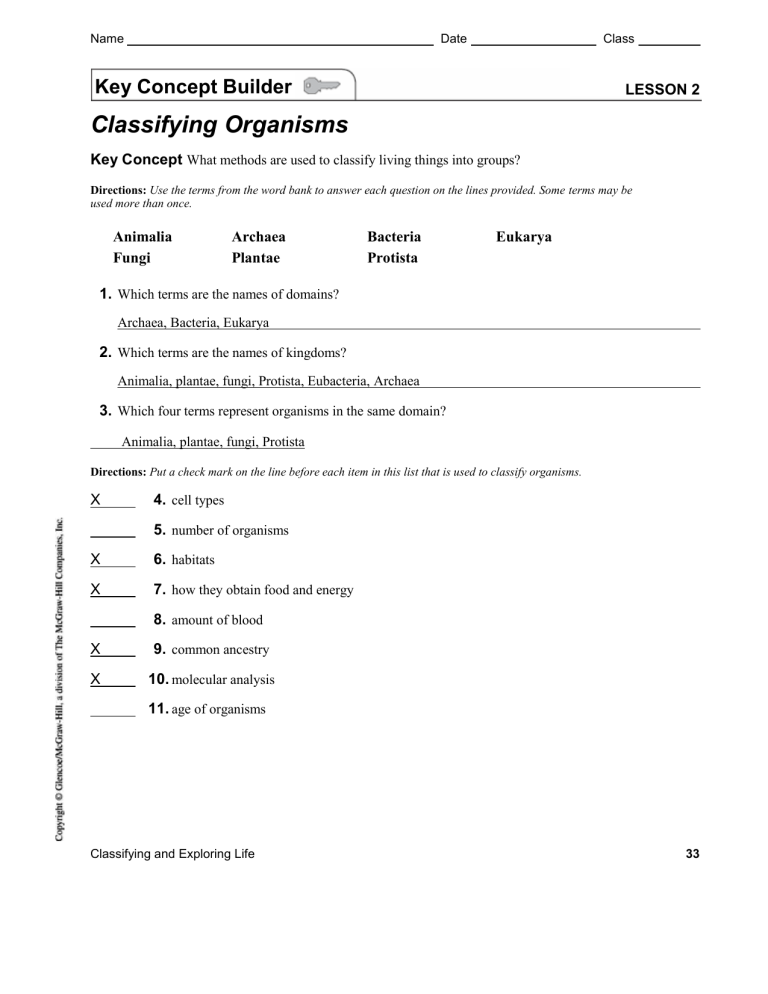
Name
Key Concept Builder
Date
Classifying Organisms
Key Concept What methods are used to classify living things into groups?
Class
LESSON 2
Directions: Use the terms from the word bank to answer each question on the lines provided. Some terms may be used more than once.
Animalia Archaea Bacteria Eukarya
Fungi Plantae Protista
1. Which terms are the names of domains?
Archaea, Bacteria, Eukarya
2. Which terms are the names of kingdoms?
Animalia, plantae, fungi, Protista, Eubacteria, Archaea
3. Which four terms represent organisms in the same domain?
Animalia, plantae, fungi, Protista
Directions: Put a check mark on the line before each item in this list that is used to classify organisms.
X 4. cell types
X
X
5.
6.
7. number of organisms habitats how they obtain food and energy
X
8. amount of blood
9. common ancestry
X 10. molecular analysis
11. age of organisms
Classifying and Exploring Life 33
Name
Key Concept Builder
Classifying Organisms
Date Class
LESSON 2
Key Concept What methods are used to classify living things into groups?
Directions: The system used to classify organisms has changed over time. Put each system listed below in the order it was used, starting with the oldest system.
Aristotle’s two groups, plants and animals
Linnaeus’s two-kingdom system, plants and animals
Systematics
Whittaker’s five-kingdom system
1. Aristotle’s two groups, plants and animals
2. Linnaeus’s two-kingdom system, plants and animals
3.
Whittaker’s five-kingdom system
4. Systematics
Directions: Answer each question on the lines provided.
5. What does Whittaker’s system have that Linnaeus’s system does not?
Five kingdoms
6. What does systematics have that the other systems do not?
Six kingdoms and three domains
7. Why is the system of classifying organisms still changing?
New organisms are constantly being discovered, and new information is being uncovered from know organisms.
34 Classifying and Exploring Life
Name
Key Concept Builder
Classifying Organisms
Date
Key Concept What methods are used to classify living things into groups?
Directions: Answer each question or respond to each statement on the lines provided.
1. Imagine that you just observed an insect landing on your desk. How can a dichotomous key help you identify the kind of insect you saw?
Match characteristics from the chart to observations of the insect
2. Write two questions you might see in a dichotomous key for insects.
Does it have wings?
Is it under 4mm?
3. What is the diagram below called?
Cladogram
Salamander
Lizard
Hamster
Chimpanzee
Salmon Opposable thumbs
Fur, mammary glands
Claws or nails
Lungs
4. Which organisms shown have claws or nails?
Lizard, Hamster, Chimpanzee
5. Which organisms shown do not have opposable thumbs?
Salmon, Salamander, Lizard, Hamster
Classifying and Exploring Life
Class
LESSON 2
35
Name
Key Concept Builder
Classifying Organisms
Date
Key Concept Why does every species have a scientific name?
Directions: Work with a partner to answer each question on the lines provided.
1. What system is used to give an organism a scientific name?
Binomial Nomenclature
Class
LESSON 2
2. What are the two words in a scientific name?
Genus and Species
3. Are more kinds of organisms in a species or in a genus? Explain your answer.
More in a genus. A genus is more general and a species is more specific
4. Why are scientific names important for scientists to use?
Scientific names eliminate confusion among scientist, because each organism is given a unique scientific name which is used by all scientists around the world regardless of langue.
Directions: List each taxonomic group from largest to smallest on the lines provided. class domain family genus kingdom order phylum species
5.
Domain, Kingdom, Phylum, Class, Order, Family, Genus, Species
36 Classifying and Exploring Life


